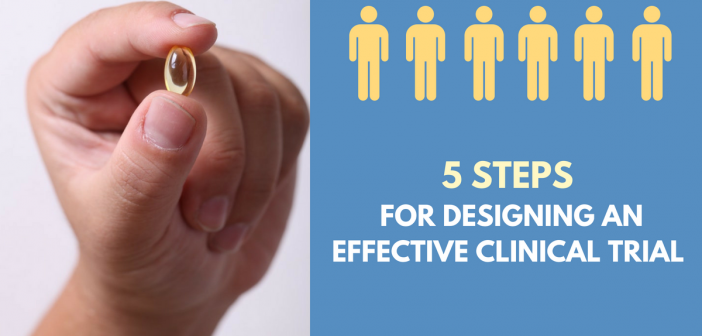Hiring a freelance clinical trials expert can be a cost-effective solution if you need to consult a qualified expert, on demand.
In this post, Jesica Levingston Mac Leod, PhD-qualified scientist and Kolabtree freelancer, provides 5 steps to design a clinical trial successfully and take your product/device to market.
Congratulations! After years of research, you finally have a lead drug/device that can take the leap of faith and start the clinical trial process. The appropriate design of this trial can help you reach a successful outcome and delivering your drug/device to the rest of the world. Here are some simple and very important steps to keep in mind when you’re going to design a clinical trial.
1. Make it simple
Aim to answer only one question and/or formulate only one hypothesis. Limit the protocol complexity to its minimum. Build up the project from the big picture to the smaller parts. Things will get complicated, indeed fulfilling all the regulatory protocols is quite complex and for this be sure to hire the best professionals you can find. Have in mind that you need to send the data to the Food and Drug Administration (FDA), or your local equivalent, for approval to continue research and testing before starting any of the 4 phases of clinical trials.
2. Patient and associated professionals recruitment is a key determinant of success
The correct identification and engagement of a diverse group of stakeholders, from investigators and sponsors to patients, and keeping constant open communication (including their input and representation on related committees) are the critical starting points.
Some tips:
- Diminish procedures and activities that create additional work for sites and patients.
- Identify and eliminate items that are not necessary for ensuring safety of participants and keep the ones directly relevant to answering the primary research question.
- Choose and report the methods of randomization correctly.
- Seek for the cutting edge stratification methods.
- Balance the study group using the stratification technique. At least, outcomes evaluation should be blinded.
- Collect only the data necessary to maintain participant safety and address the main question.
- Develop a plan to regularly meet with the stakeholders.
- Schedule timely meetings to examine recruitment successes and challenges and ask sites if they need support to guaranty efficient and effective recruitment.
- Create a short survey for persons offered enrollment but who decline to participate.
- Choose the best key opinion leaders and professionals that you can find, if they can’t join you, ask for referrals to find the best second option.
- Create a diverse group, include marketing, regulators, medical doctors, scientist, executives, etc, and educate them on each other’s roles and duties.
3. Plan the 4 phases with the goal of your clinical trial in mind
In Phase I the studies shall assess the safety of a drug/device, it might include a small number of healthy volunteers (20 to 100), with the aim to determine the effects of the drug/device, like how it is absorbed, metabolized, and excreted, and possible side effects that occur as dosage levels are increased.
In Phase II the study must test the efficacy of a drug/device. Most phase II studies are randomized trials; it is preferable if the study is “blinded” as this allows investigators to provide the pharmaceutical company and the FDA with comparative information about the relative safety and effectiveness of the new drug.
In Phase III the studies involve randomized and blind testing in hundred to several thousand patients, this provides both the company and the FDA with data on the effectiveness of the drug/device, the benefits and the range of possible adverse reactions. Very importantly, once Phase III is complete, the company can request FDA approval for marketing the drug.
In Phase IV or Post Marketing Surveillance Trial, the aim is to compare a drug/device with other drugs/devices already in the market; to monitor a drug’s long-term effectiveness and impact on a patient’s quality of life; and to determine the cost-effectiveness of a drug therapy relative to other traditional and new therapies.
4. Develop an adequate budget and resources plan
Create milestones and a way to keep the cost on track. Find the best way to measure the performance, remember: If you can’t measure it, you can’t improve it.
5. Try to poke holes on your design and protocols
Run an environmental scan or SWOT (strengths, weaknesses, opportunities, threats) analysis, include competition, policy, seasonal fluctuations, awareness, disease stage and rarity, satisfaction with current therapies, and economic concerns. Anticipate unwanted events to identify potential pitfalls and bottlenecks, you can use historic and bench-marked data to estimate realistic timelines. A bulletproof clinical trial design has to be tested in the most inconvenient ways in order to be more secure and safe.
The take home message is that a clinical trail designed with a clear aim, milestones and timeline, by a team of diverse and knowledgeable professionals, working in open and safe environments, where ideas and feedback are welcome can help you to expedite and improve the process to bring your drug/device to the market and change the world.
References:
- https://www.sciencedirect.com/science/article/pii/S155171441730753X
- https://www.ncbi.nlm.nih.gov/pmc/articles/PMC5594116/
- https://www.centerwatch.com/clinical-trials/overview.aspx
——–
Need help to design a clinical trial? Consult a clinical trials expert on Kolabtree. Post a project and get quotes for free.
Related Experts:
Clinical research consultants | Biotechnology | Biostatistics | Bioinformatics| Clinical trial protocols | Clinical evaluation writing | Medical device consulting | Genetics and Genomics







